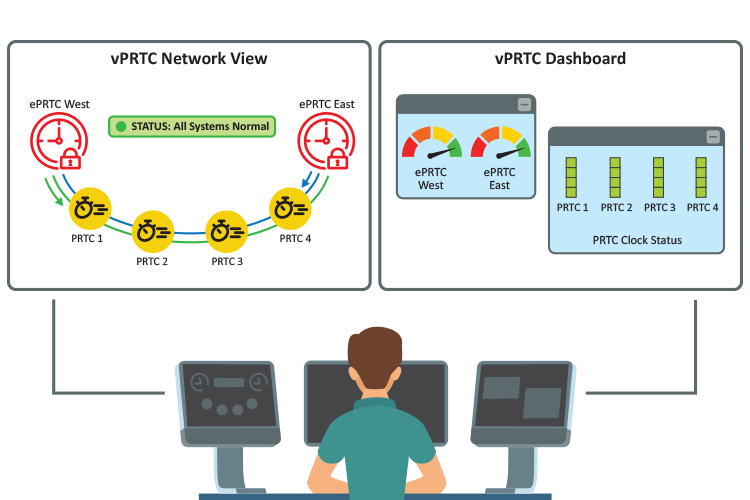Need Help?
Privacy PolicyLive Chat
An Innovative Architecture for Resilient Timing

The vPRTC is simple in concept. It blends proven timing technologies into a centralized and protected source location and uses commercial fiber optic network links and advanced IEEE® 1588 Precision Time Protocol (PTP) boundary clocks to distribute 100 ns PRTC timing where it is needed—in end points that might be hundreds of kilometers away. The central locations receive their UTC time traceability from GNSS via highly protected and validated receivers. Advanced firewall technologies continuously monitor for threats in the form of GNSS spoofing or jamming attacks to ensure that only valid signals from the sky are passed to the central clock. The vPRTC uses industry-proven cesium atomic clocks to establish 30 ns accuracy traceable to Universal Time Coordinated (UTC). If an invalid GNSS signal is detected or denied, the vPRTC source maintains ±100 ns traceability to UTC for a minimum of 14 days.
With these highly resilient atomic clocks in place, critical infrastructure operators can use their secure fiber network to distribute timing to all necessary locations. Just as a GNSS satellite-based timing system distributes timing to end points using open-air transmission, the vPRTC distributes timing using the fiber network. The difference is that the operator remains 100% in control of the network and can secure it as necessary. The vPRTC architecture can be deployed as the sole source of timing or it can be deployed as a backup to GNSS timing solutions.
Explore These Three Components of the vPRTC

GNSS
Monitoring and protection are provided by our secure BlueSky™ GNSS firewall technology:
- Creates highly secure GNSS systems to calibrate and align the vPRTC solution to UTC
- Shields your critical infrastructure from GNSS jamming and spoofing attacks

Atomic Clocks
High-precision atomic system clocks are at the heart of the vPRTC system:
- Provide an autonomous time scale that can maintain accurate time if GNSS is impaired
- Represent the world standard in timekeeping

Trusted Time
Our portfolio of solutions help establish a trusted timescale:
- TimeProvider® 4100 Enhanced Primary Reference Time Clock combines the atomic clock and validated GNSS inputs
- High-performance PTP boundary clocks distribute time over your wide area network with a budget of less than 5 ns per hop
- TimePictra® Synchronization Management System monitors and manages these functions
Learn About Resilient Timing for Critical Infrastructures
The virtual Primary Reference Time Clock is a highly resilient timing architecture that reduces reliance on Global Navigation Satellite System (GNSS)-based timing signals.

Learn About Resilient Timing for Critical Infrastructures
The virtual Primary Reference Time Clock is a highly resilient timing architecture that reduces reliance on Global Navigation Satellite System (GNSS)-based timing signals.

Learn About Security and Resilience for Timing and Synchronization
Hear from our Barry Dropping in a newly-released ITSF 2022 interview.